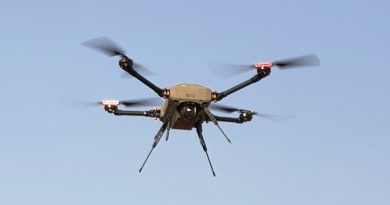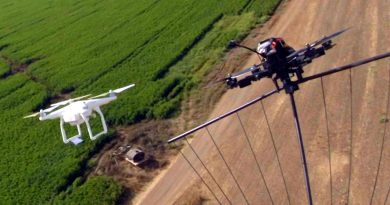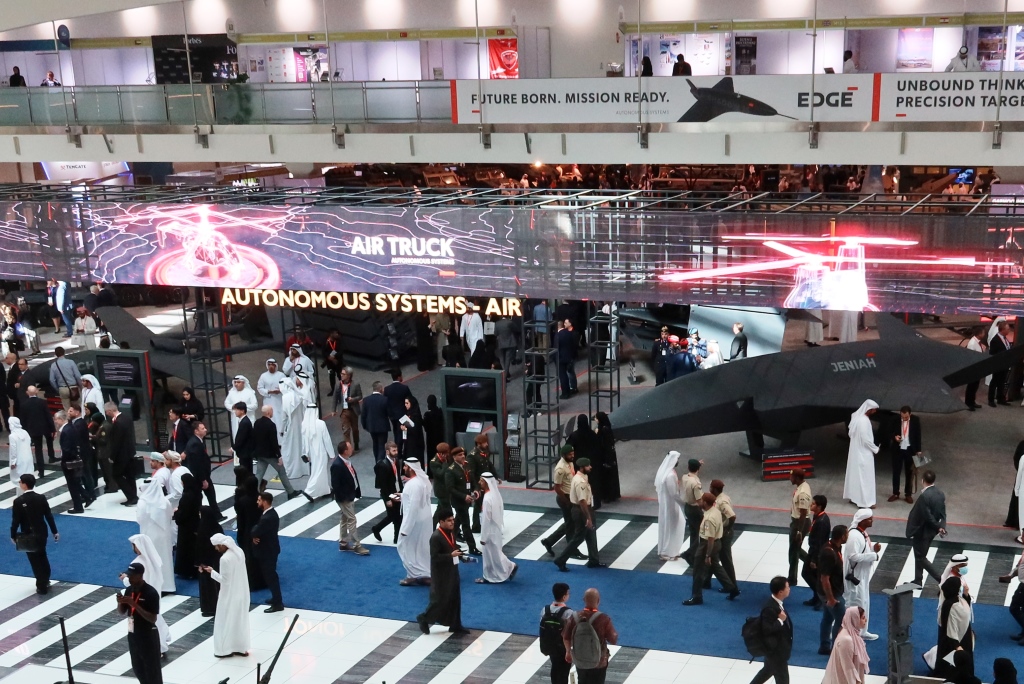
Inside EDGE – A view from the top
During the familiarisation trip to Abu Dhabi to provide international media with a deeper knowledge of the EDGE Group, EDR On-Line had the chance to meet Hamad Al Marar, who became the EDGE Managing Director and CEO on February 1st, 2024, who we also met at the World Defense Show in Riyadh in early February
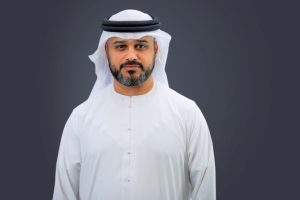
When the meeting took place, in late February, financial results, those for 2023 were not yet available; in 2022 the group totalled over USD 5 billion order intake, of which around 30% from export. This was a peak compared to previous years, when 20% was coming from outside UAE borders. “As I already said in the past, the right balance would be 40% export and 60% national, and I think we are on the right trajectory to reach that target, the CEO adds.
EDGE has grown in dimensions, through consolidations and acquisition. In late January 2024 it announced the addition of the International Golden Group (IGG) to the company portfolio. As a leading agent for high-end defence supplies, IGG will allow EDGE to further expand its offer to end users. The move was due to the fact that the Strategic Defense Fund (SDF) was moved within EDGE, and as that fund was owning IGG, the latter also moved within the group. It was the last Government owned company; therefore, the CEO does not foresee further consolidations in country. Speaking about the reasons for the creation of EDGE in late 2019 he explained that “The consolidation aimed at bringing some governance to every company owned by the Government or any company with export potential at a certain scale,” adding that “having a conglomerate like EDGE makes sense, it gives us the economy of scale as well as the size and critical mass to appear in the top 25.”
Looking at other defence industry realities in the country, he added that “there are so many synergies in production, integration and design, that these would add more value than the acquisition itself,” letting us understand that at least within the UAE borders the consolidation work is finished.
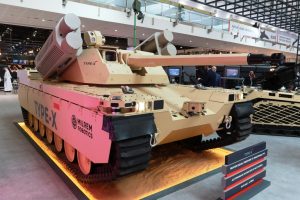
This might not be true looking at the wider world. Here acquisitions are driven by the need to get a new engineering capacity, a technology, a subsystem, considerations being never uniquely financial. Acquiring an entity in a foreign country “Allows us to get a foothold in that country, in that region. The relationship becomes a country-to-country one and grows to furtherly support their own forces with the solutions we can provide,” Hamad Al Marar underlines.
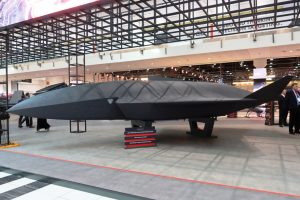
Coming to products, with missiles and UAS in its portfolio, EDGE is aiming at developing its own propulsion capabilities. A first move was the signature of a strategic agreement with Turbomachine, one of Brazil’s foremost turbine engine developers. EDR On-Line understood that EDGE has already started developing its own solution. “A turbojet engine has already been designed, it has been tested on the bench, and I hope we will be demonstrating it in a year’s time. It has been an exciting and interesting development,” Hamad Al Marar announced. “The facilities are under construction and within the next two years we will have a complete independence in propulsion.”
This will not be the case for internal combustion engines; here EDGE is cooperating with a local engine manufacturer, which designed a propulsor capable to replace the one currently used on the 600 kg MTOW REACH-S, used for intelligence, surveillance, and reconnaissance and also able to carry out precision ground attack missions. This MALE UAS is currently powered by a Rotax 912 engine providing 110 hp. EDGE CEO considers a success the fact that an ecosystem dedicated to defence and high tech is growing around the Group, providing in-country solutions.
Following recent events in Eastern Europe, ammunition production has become an issue, many countries finding themselves with an undercapacity to manufacture a number of rounds compatible with wartime consumption rate. “Considering the three main categories, primed, medium fused and large fused, in each one there is a different level of industry involved,” Hamad Al Marar explains. “Looking at large calibre ammunition, you need forging plants, however I can get the shell design I need from many forging plants around the world, at low price, and they have no shelf life, so building up a forging plant is not among my priorities.” He stresses that in this field forming alliances is the solution, and underlines how Saudi Arabia is willing to create an ammunition industry. “If they will produce 100% of their capacities, I will need only 20-30% of those. This means economies, so for me it does not make sense to duplicate such capabilities, I would rather support them, get the product from them, and support them in exporting their ammunition,” the EDGE CEO adds. That said, from a strategic viewpoint having a dual source would make sense; however should this happen, the UAE capacity will be complementary to the Saudi one. While Lahab Light Ammunition has 100% control over the production of small calibres, Lahab Defence Systems have capacity in artillery shells and mortar ammunition, EDGE aiming in due time to develop a capacity in medium calibre ones.
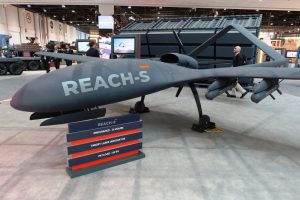
In the last defence exhibitions one entity of EDGE, Advanced Concepts, unveiled several new concepts. “The Group established Advanced Concepts to offload many of the advanced projects from the core business not to deviate or redirect people into something that is experimental”, the Group CEO explains. In the last issue of the EDGE catalogue Advanced Concepts programmes include REACH-S, REACH-M and Jeer UAS, the Hunter family of loitering munitions, and the Tactical UGV 5IS, with its dedicated remotely controlled weapon station. Once validated some of those projects might be shifted to the relevant entity and become a product. EDR On-Line understood that in many cases the objective of those experimental programmes is not necessarily to reach product status but rather to show that there is a proper concept that the industry can take forward, eventually developing key elements that might become useful at a later stage.
In some cases, those programmes come to fruition. “Take for example loitering munitions. We developed the Hunter range, and now this is being moved to ADASI to become a military product. ADASI will be responsible for the airframe, the launch mechanism, and so on, while the payload will come from Halcon and Lahab.”
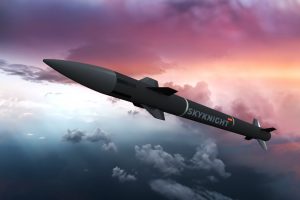
Another key programme is the Skynight ground-to-air missile, designed to be part of a hybrid low-tier air defence system that also includes 35 mm guns, with among other a C-UAS capability. “The rules of the game have changed, and although guns and fire control system are very reliable, there is the need for a missile, and we will bring the missile element,” Hamad Al Marar said. Originally the missile was developed by Denel Dynamics in South Africa, and was known as Cheetah, but then the programme had some issues, and EDGE decided to take it further, the cooperation on the overall Skynight system being now only with Rheinmetall. And more specifically its entities in Switzerland and Italy, no more ties existing with South Africa.
Designed for becoming the longer-range element of the Skynight, the missile can however be easily integrated in other VSHORAD systems. The CEO explains that while retaining an active radar seeker, HALCON offloaded all what was possible from the missile to the ground control system, the latter doing all the tracking and guidance until the very last phase of the attack, where the missile seeker takes over. According to Hamad Al Marar the Skynight missile used a radar-on-a-chip solution, which is produced in a foundry, EDGE currently outsourcing this production. The Skynight missile maximum range is declared at 10 km, guns having a range of 4 km. A 20-feet containerised missile launcher unit capable to host 60 missiles, with a five missiles per second rate of fire, is being developed.
As seen in the opening of this article, EDGE aims at increasing its export share, the United States being obviously a huge opportunity, for example in the small arms field. “We are not mature enough to handle the US market,” Hamad Al Marar stated that, however, he also underlined that the very lucrative small arms market is of great interest and EDGE will develop and form alliances to penetrate that market. In fact, the US market is already consuming 30 to 40% of small arms ammunition produced by the Group.
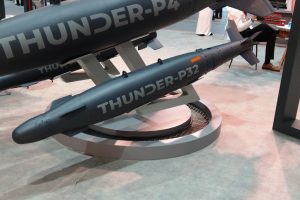
“I was actually even thinking beyond small arms and to other clusters, especially missiles and weapons,” the CEO said. The UAE buy of 18 MQ-9B SkyGuardians is still pending; approved by the US Department of State in 2020, it was frozen by the Biden administration one year later. EDGE filed an agreement with General Atomics Aeronautic Systems Inc. (GA-ASI) to integrate its Desert Sting guided glide weapons, Thunder precision guided munitions (PGM), and Al Tariq long range systems, on the MQ-9B. Although this is aimed at the UAE contract, it should well be an entry point as it adds flexibility to GA-ASI export proposals. It is to note that the EDGE integration, when implemented, will be the first of non-NATO weapons on that UAS. The deal was unveiled at the Dubai Air Show in November 2023; “To me this announcement was by itself a success, and it opens up users everywhere in the world. Of course, we will always be subjected to America regulations, but that’s not an issue,” the CEO added, underlining that EDGE guided weapons are already being integrated on UAE Air Force Mirage 2000s.
Photos courtesy EDGE and P. Valpolini

